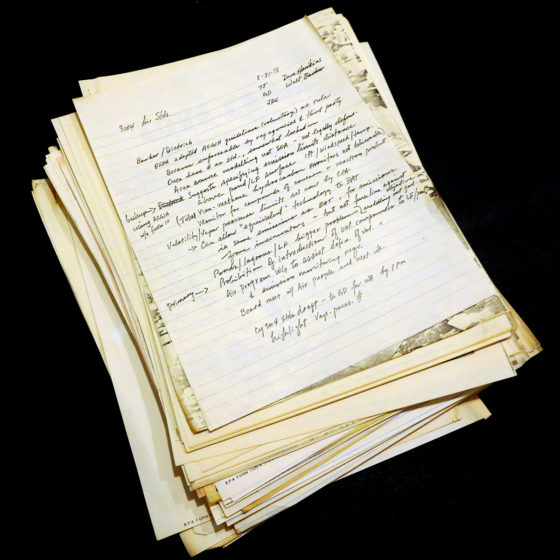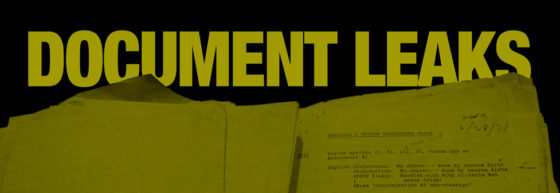William Sanjour is perhaps the EPA’s best-known whistleblower. He spent many of his nearly 30 years at the EPA exposing government corruption and assisting local and national efforts to combat incinerators, hazardous waste dumps, and other EPA and governments abuses. He also testified before Congress many times. William Sanjour was featured in the documentaries The Killing Ground (ABC, 1979), In Our Water (1982) and The World According to Monsanto (2008).
In 1974, William Sanjour was appointed a branch chief at EPA, at the newly formed Hazardous Waste Management Division. With a staff of about 20 engineers and scientists and a budget of about $10 million, his task was to research hazardous waste and its impacts and safe disposal. Later he was to supervise drafting of regulations required to implement the Resource Conservation and Recovery Act.
In 1978, under pressure from the Carter White House, and to please the waste disposal industry, senior EPA officials sought to undermine regulation specifically designed to reduce the production of hazardous waste. Beginning his long career as a whistleblower, William Sanjour fought these efforts to weaken environmental protection and thus endanger public health.
 To keep track of the relevant paperwork throughout his EPA tenure, William Sanjour implemented a meticulous filing system. In May 2018, William Sanjour gave his complete collection of EPA files to the Bioscience Resource Project. The Bioscience Resource Project funded and managed the digitization of the Sanjour Hazardous Waste Files, and in November 2018 the digitized Files were made publicly available on DocumentCloud, a searchable web repository: https://www.documentcloud.org/projects/41513-sanjour-hazardous-waste-files/
To keep track of the relevant paperwork throughout his EPA tenure, William Sanjour implemented a meticulous filing system. In May 2018, William Sanjour gave his complete collection of EPA files to the Bioscience Resource Project. The Bioscience Resource Project funded and managed the digitization of the Sanjour Hazardous Waste Files, and in November 2018 the digitized Files were made publicly available on DocumentCloud, a searchable web repository: https://www.documentcloud.org/projects/41513-sanjour-hazardous-waste-files/
The documents are also archived at the UCSF Chemical Documents Library and can be searched at: William Sanjour Hazardous Waste Papers.
The Digitized Sanjour Hazardous Waste Files are William Sanjour’s personal work files from 1974 to 2001. The files served as the basis of his later Internet memoir “From the Files of a Whistleblower: How EPA was Captured by the Industry it Regulated“. This memoir can be used as a guide to the digitized collection.

Additional Information
The Sanjour Hazardous Waste Files contain:
- Memos and notes to and from William Sanjour, from his staff, from industrial sources and trade associations, from Congress, from citizen groups impacted by hazardous waste dumping and to anyone else if it impacted on his responsibilities.
- Congressional hearings, newspaper clips, and magazine and journal articles and EPA reports.
The files record:
- Evolution of important EPA regulations.
- Political pressures on EPA regulators originating from inside and outside the EPA.
- Day to day efforts of a whistleblower to defend himself and to pursue the public interest.
- Pressures brought to bear on whistleblowers to silence them.
What’s in My Files
By William Sanjour
June, 2018

I have a very poor memory. Always have had. So when I was appointed a branch chief at EPA at the newly formed Hazardous Waste Management Division in 1974 and given a staff of about 20 engineers and scientists and a budget of about $10 million, I created a filing system to keep track of all the relevant paper work that crossed my desk each day. I had two principal responsibilities, 1) to research and document the environmental and human health problems associated with the unregulated haphazard dumping of industrial hazardous waste, which had recently attracted the interests of the environmental community and the U.S. Congress, and 2) to research better and safer methods of treating and disposing of these wastes.
My files included memos and notes to me and from me, from my staff, from industrial sources and trade associations, from Congress, from citizen groups impacted by hazardous waste dumping and to anyone else if it impacted on my responsibilities. They also included Congressional hearings, newspaper clips, and magazine and journal articles.
In 1976, Congress passed a law, largely based on our research, giving EPA the responsibility of writing regulations to protect human health and the environment from the consequences of this dumping. Some of the responsibility for drafting new regulations fell to me and my branch.
My files then became an historical record of the day-to-day evolution of important environmental regulations viewed from inside the bowels of EPA. A record from the regulators of all the pressures brought to bear on the regulators. Pressures from industry, from other administrative government agencies including the White House, pressures from Congress, and especially pressures from inside EPA.
In 1978 a blow was struck which changed everything for me for the rest of my life. The White House, in a misguided attempt to fight inflation, ordered EPA to cut back regulations in order to gain support form industry to help reduce inflation. At first I fought this heartless and illegal action and was rewarded by being transferred to a meaningless position. I then went public and gained allies within Congress, the press, and environmental organizations.
My files for the next 20 years became a record of the day-to-day workings of a whistleblower and all the dirty tricks the U.S. government used to silence me and fire me, including passing a law (which was later ruled unconstitutional), and all the ways me and my allies thwarted the government and allowed truth of government corruption to emerge.
Learning about and reporting EPA and other government corruption indeed became my theme until I retired in 2001. My activities as a whistleblower brought me in contact with grassroots environmental groups around the country and invitations to address citizen’s meetings in North Carolina, Pennsylvania, Massachusetts, Georgia, Missouri, and Canada where I learned and spoke about EPA collusion with the very people EPA was supposed to be regulating.
 I testified at legal proceedings in Colorado and Puerto Rico. I addressed grass-roots leadership conferences in Ohio, Kentucky and Virginia. I testified at state legislatures in West Virginia, Georgia, and North Carolina. I was asked to testify in the U.S. Congress on five occasions about EPA corruption. I’ve written many articles on hazardous waste issues and about EPA’s corrupt policies, and I have appeared on several TV and movie documentaries. I believe my knowledge and ideas have been influential in the passage of many state and federal laws governing hazardous waste as well as protecting the rights of fellow civil servants to blow the whistle.
I testified at legal proceedings in Colorado and Puerto Rico. I addressed grass-roots leadership conferences in Ohio, Kentucky and Virginia. I testified at state legislatures in West Virginia, Georgia, and North Carolina. I was asked to testify in the U.S. Congress on five occasions about EPA corruption. I’ve written many articles on hazardous waste issues and about EPA’s corrupt policies, and I have appeared on several TV and movie documentaries. I believe my knowledge and ideas have been influential in the passage of many state and federal laws governing hazardous waste as well as protecting the rights of fellow civil servants to blow the whistle.
One example of how my files protected me was when, for the first time in my career I was given an unsatisfactory performance evaluation. This is usually the first step toward termination. I filed a grievance and from my files I was able to demonstrate that the charges were bogus. But the clincher was that I discovered that only two people had received an unsatisfactory evaluation and the other one was also a whistleblower. Then I searched my files for a recent newspaper clipping which quoted my boss, EPA Deputy Administrator Rita Lavelle, advocating that whistleblowers should be fired. That got EPA to withdraw the evaluation. (Lavelle was later jailed for giving EPA money to big contributors.)
Even after I retired my files served me well. I was hired as a witness by the defendants in a lawsuit between a giant corporation and its insurance companies. The corporation was trying to get the insurance companies to pay for cleaning up a massive dumping of hazardous wastes. The company claimed that no one knew the waste was hazardous at the time it was dumped and their expert witness to this claim was my retired ex-boss at EPA. Searching my files I found reports that we had briefed this company, and many others, about the danger of these wastes long before they were dumped and the company had simply ignored our warnings.
William Sanjour’s articles on Independent Science News
How the Once Tiny Waste Management Industry Captured EPA and Became VERY BIG
Designed to Fail: Why Regulatory Agencies Don’t Work
More on William Sanjour’s work and whistleblowing
National Whistleblowers Center
https://www.whistleblowers.org/meet-the-whistleblowers/90-william-sanjour
Professionalism/William Sanjour and the EPA – Wikibooks
https://en.wikibooks.org/wiki/Professionalism/William_Sanjour_and_the_EPA
Documentaries

The Killing Ground (1979 Documentary) An episode of ABC News CloseUp from 1979 focusing on the problem of disposing hazardous chemical wastes. Points out the ineffectiveness of local, state, and federal agencies in dealing with deadly chemical toxins in the environment. Profiles Love Canal in Niagara Falls, NY, Kin-Buc landfill in Edison, NJ, and in Louisiana among other locations. Host is Brit Hume. https://www.youtube.com/watch?v=F4udLhOdPro
In Our Water (1982 Documentary) A New Jersey family discovers their drinking water is contaminated with deadly poisons from a nearby landfill. Director: Meg Switzgable See https://www.kanopy.com/wayf/product/our-water
The World According to Monsanto (2008 Documentary) Monsanto’s (now Bayer’s) controversial past combines some of the most toxic products ever sold with misleading reports, pressure tactics, collusion, and attempted corruption. They now race to genetically engineer (and patent) the world’s food supply, which profoundly threatens our health, environment, and economy. Combining secret documents with first-hand accounts by victims, scientists, and politicians, this widely praised film exposes why Monsanto has become the world’s poster child for malignant corporate influence in government and technology. A film by Marie-Monique Robin. https://www.youtube.com/watch?v=6nNFmzAOtJI
Whistleblowers on Donahue Whistleblower Interviews | EPA Whistleblower William Sanjour Featured https://www.youtube.com/watch?v=MHidCuPZWLs
